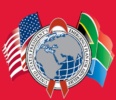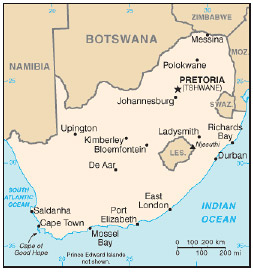| 2008 Country Profile: South Africa PDF version PDF version

 |
|
2008 Country Profile: South Africa
National HIV prevalence rate among adults (ages 15-49): 18.1 percent1
Adults and children (ages 0-49) living with HIV at the end of 2007: 5.7 million1
AIDS deaths (adults and children) in 2007: 350,0001
AIDS orphans at the end of 2007: 1.4 million1
South Africa is one of PEPFAR’s 15 focus countries, which collectively represent approximately 50 percent of HIV infections worldwide. Under PEPFAR, South Africa received nearly $89.3 million in fiscal year (FY) 2004, nearly $148.2 million in FY 2005, more than $221.5 million in FY 2006, and $397.8 million in FY 2007 to support comprehensive HIV/AIDS prevention, treatment and care programs. PEPFAR is providing nearly $590.9 million in FY 2008. | |
Recognizing the global HIV/AIDS pandemic as one of the greatest health challenges of our time, President George W. Bush announced the President’s Emergency Plan for AIDS Relief (PEPFAR) in 2003 — the largest international health initiative in history by one nation to address a single disease. The United States is changing the paradigm for development, rejecting the flawed “donor-recipient” mentality and replacing it with an ethic of true partnership. These partnerships are having a global impact and transforming the face of our world today.
Partnership to Fight HIV/AIDS
The South Africa Government is updating the HIV/AIDS/STI Strategic Plan for 2000-2005 with the National Strategic Plan 2007-2011. The National Strategic Plan identifies a range of interventions to address HIV/AIDS, including the scale-up of the provision of antiretroviral treatment. Through PEPFAR, the U.S. Government (USG) supports implementation of the South African Government’s Strategic Plan and works with more than 300 diverse partners, including governmental partners at all levels, academic institutions, non-governmental organizations, faith-based organizations, and private-sector partners.
Several other key principles also guide the PEPFAR response in South Africa:
- Evidence-based programming selected and designed on a sound research base;
- Rigorous assessment of all activities through regular and accurate reporting and targeted evaluation to monitor the achievement of targets and ensure high-quality performance;
- Enhancing human and infrastructure capacity to help South Africa achieve its health and social goals related to HIV/AIDS while strengthening the overall public health system; and
- Designing sustainable programs and service improvements.
| PEPFAR Results in South Africa |
| # of individuals receiving antiretroviral treatment as of March 31, 20081 |
|
435,100 |
| # of HIV-positive individuals who received care and support in FY2007 (including TB/HIV)1 |
|
984,500 |
| # of orphans and vulnerable children (OVCs) who were served by an OVC program in FY20071 |
|
365,000 |
| # of pregnant women receiving HIV counseling and testing services for PMTCT since the beginning of PEPFAR1,2 |
|
2,211,000 |
| # of HIV-positive pregnant women receiving antiretroviral prophylaxis for PMTCT since the beginning of PEPFAR1,3 |
|
333,100 |
| # of counseling and testing encounters (in settings other than PMTCT) in FY20071 |
|
1,742,300 |
| # of individuals reached with community outreach HIV/AIDS prevention programs that promote Abstinence and/or Being Faithful in FY2007 |
|
5,173,800 |
| # of individuals reached with community outreach HIV/AIDS prevention activities that promote Condoms and related prevention services in FY2007 |
|
2,263,000 |
| # of USG condoms shipped from Calendar Year 2004 to 20074 |
|
330,000 |
|
Note: Numbers may be adjusted as attribution criteria and reporting systems are refined.
Numbers above 100 are rounded to nearest 100.
1 Total results combine individuals reached through downstream and upstream support.
2 It is possible that some individuals were counseled and tested more than once.
3 It is possible that some pregnant women received antiretroviral prophylaxis more than once over the four-year period, e.g. HIV positive women who were pregnant more than once.
4 The South African Government is committed to providing free condoms and does not require USG support for condom procurement. Through PEPFAR, the USG continues to provide technical assistance in support of the condom procurement and distribution programs in order to have a greater effect on behavior change. |
 |
PEPFAR Achievements in South Africa to Date |
|
HIV/AIDS in South Africa
South Africa’s AIDS epidemic is one of the worst in the world. It is a generalized epidemic, affecting all segments of society. In 2005, the Human Sciences Research Council released updated information on HIV prevalence and HIV-related risk behaviors. Of the study population, 10.8 percent were HIV-positive. The findings on behavior change showed that nearly half of all men and more than one-third of women over 15 years of age reported behavior change, including abstaining from sex, being faithful to one partner, reducing the number of sexual partners, and using a condom.2 These behavior changes may be related to strong prevention programs implemented by a wide range of stakeholders, including the South African Government, non-governmental organizations, and faith-based organizations. However, HIV data gathered in the country’s extensive antenatal clinic surveillance system suggest that HIV prevalence has not yet reached a plateau, and is still increasing among certain population groups.3
Challenges to PEPFAR Implementation
Over the next few years, South Africa will greatly increase the entire spectrum of HIV/AIDS |
|
 |
| interventions. The health system response must continue to scale up to provide antiretroviral treatment (ART) for additional patients, and also must cope with long-term support for the increasing numbers of patients on ART. This is made difficult by the loss of skilled professionals to wealthier countries, as well as stigma and widespread skepticism about Western medicines. At the same time, more than one million orphans and perhaps millions of people living with HIV/AIDS will need access to social and health services by 2008. While PEPFAR will contribute substantial support to an integrated program in treatment and care, efforts on prevention to ensure the majority of South Africans remain HIV negative are essential. South Africa’s unique economic, educational and infrastructure advantages will help it overcome many resource constraints and social challenges it shares with other focus countries.
Critical PEPFAR Interventions for HIV/AIDS Prevention:
- The Mothers to Mothers-to-Be program empowers women in the prevention of mother-to-child HIV transmission (PMTCT) by providing psychosocial support, promoting women’s economic independence, reducing stigma, and promoting disclosure in families and communities.
- By challenging the gender-related beliefs and attitudes that encourage men to equate masculinity with dominance over women, the pursuit of multiple partners and other risk-taking behaviors, the Men as Partners program uses a range of strategies – workshops, community education, media advocacy and public policy – to encourage young and adult men to remain abstinent, to be faithful and to decrease their number of sexual partners, thereby reducing the risk-taking behavior that puts themselves and partners at risk.
- With a focus on children, Soul Buddyz Club has produced 26 half-hour TV drama series, 26 radio spots, one million copies of a 42-page coloring book, as well as promotional material to spread messages about HIV prevention.
Critical PEPFAR Interventions for HIV/AIDS Treatment:
- PEPFAR supports South Africa Government policies and guidelines to strengthen comprehensive high quality care for people living with HIV/AIDS by scaling-up existing effective programs and best practice models in the public, private and non-governmental sectors; providing direct treatment services through 20 prime partners and their sub-partners; increasing the capacity of the South African Government to develop, manage and evaluate HIV/AIDS treatment programs, including recruiting additional health staff, training and mentoring health workers, improving information systems, and service infrastructure assistance; increasing demand for and acceptance of ART through community mobilization; and ensuring integration of ART programs within palliative care, TB, sexual transmitted infections (STIs) and PMTCT services.
Critical PEPFAR Interventions for HIV/AIDS Care:
- A PEPFAR partner organization replicated the Child Care Forum model to provide services to orphans and vulnerable children (OVCs). Child Care Forums act as custodians of OVCs in their community ensuring that OVCs access government services such as health and education, and providing care and support to OVCs in their community.
- Resources were provided to adapt and replicate a successful stand-alone HIV counseling and testing model to services where TB patients are diagnosed and treated.
1 UNAIDS, Report on the Global AIDS Epidemic, 2008.
2 Human Sciences Research Council, South Africa National HIV Prevalence, HIV Incidence, Behaviour and Communications Survey, 2005.
3 UNAIDS, AIDS Epidemic Update, 2006 |
| |  |  |




 PDF version
PDF version